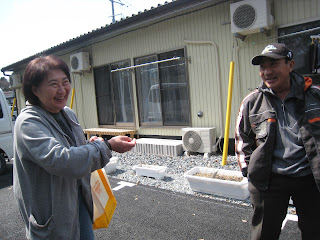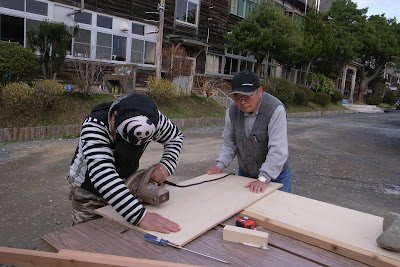August 19-24, 2012: SWTJ 15th Activity Week
SWTJ SUMMER CAMP 2012
FOR TOHOKU KIDS
 |
| The parachute-game! So much fun. |
Summer 2012. The second summer after the great earthquake and tsunami. People still stay in temporary housing, many still without jobs. Children have become used to live in cramped quarters. Many have lost relatives and friends, and some even a parent, a sibling, or both. And many had to move to unfamiliar places and find new friends in new schools.
SWTJ's summer is dedicated to these children! The children of the disaster area, who have experienced so much during the last one and a half years!
 |
| SWTJ camp participants pose in the hot morning sun! |
Purpose:
The SWTJ summer camp is not just any camp. It has been designed to empower the local children, to teach them skills, and to inspire them with enthusiasm and a dream for the future. These are the children who will lead the future of the destroyed areas of northeastern Japan. We want them to know that we care, and that despite all the destruction there is so much for them to explore, to discover, and to create in and around their new homes.
Program:
The first part of the program was dedicated to empower the kids to create a big community event for the whole neighborhood!
The children learnt how to put up tents, how to organize stands, how to invite neighbors and kids from a neighboring school, and how to entertain them.
Children learn to make 'misanga' armbands.
|
The neighborhood in Tsukidate consists of both the old rice farming community, and the new evacuee community from the coast. The children were thus part of an event that brought both communities together. Evacuee residents from the neighboring temporary container housing were invited to join camp events, and some of them turned out to be great leaders themselves!
The first task was to set up the tents. The children were taught how to do it right away. It sure was a hot day! |
| Learning how to set up a tent. |
 |
| Setting up the main tent for the camp |
Activity location:
Right next to Tsukidate Community Space, on the yard of Former Tsukidate Elementary School in Yasse, Kesennuma, Miyagi Prefecture.
The activity tent is set up!
|
Overnight tent location:
On the yard of the New Tsukidate Elementary School.
 |
| Early morning at the SWTJ overnight camp. It's going to be a hot day! |
SWTJ would like to thank both schools for kindly letting us use their yards for the Tsukidate summer camp, and the managers of the local 'Yasse Mori no Gakko' Nature Education School for their invaluable help and cooperation!
 |
| Breakfast in the activity tent |
After breakfast, the children helped cleaning up.

Buckwheat-noodle making workshop:
We all learnt how hard it is to make neatly shaped noodles! But not so evenly-shaped noodles were still delicious! Thank you to the 'Yasse Mori no Gakko' Nature Education School for providing this workshop!Playing at the nearby river was one of the most popular activities during he camp!
Nagashi-Somen for lunch! These noodles are poured into an inclined bamboo stem cut in half together with water, and kids line up along the bamboo and try to catch some of the flow. Lots of fun!
Visiting the people in temporary housing:
While most SWTJ members were busy leading the kids' camp, some others brought events to the surrounding temporary housing, together with our musicians.
 |
| Along with the summer camp, SWTJ also organized visits by SWTJ members to temporary housing to listen to recent problems and needs. |
The highlight of the camp: The campfire!
In the afternoon, everybody practiced for the evening community concert around the campfire! SWTJ musicians, including three percussionists, practiced with the children who gathered around the big 'cajon' to beat the drum together with the lead musicians. Many neighbors and evacuee residents from the temporary housing joined in. There was a great sense of togetherness.
 |
| The 'cajon' hand-made by SWTJ representative Y. Many little hands tapped the drum to the rhythm of the musicians, and it sounded really nice! |
 |
| Small fireworks finalized the evening... |
Time to say goodbye...
 |
| We all had such a good time! |
 |
| The kids write good-bye messages such as 'I hope there will be many more camps to come!' ... |
SWTJ would like to thank the many donors who made this year's summer camp possible with their generous donations!
We also received many donations in kind, including boxes of delicious onions, tissue paper, and games, among them a very original and colorful parachute-game that has become very popular during the camp with both children and adults!
THANK YOU!


























































